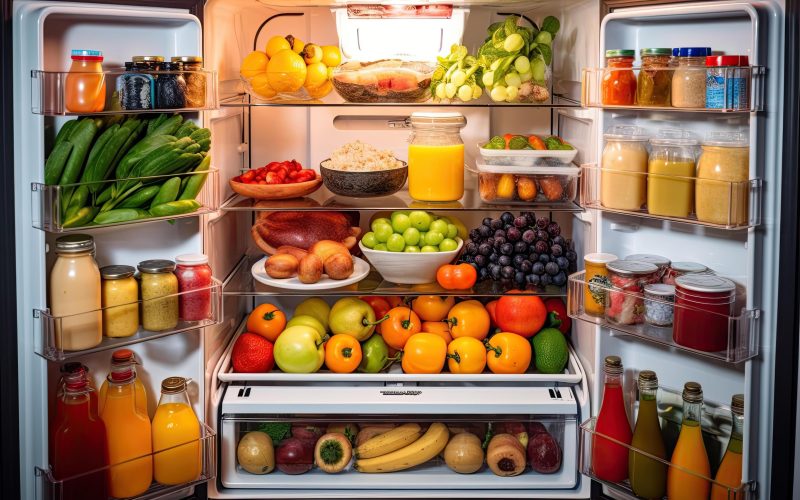Introduction
Nothing beats the taste of fresh fruits, vegetables, and meals made at home. Yet, without proper storage, freshness quickly fades. Freezing food locks in flavors, nutrients, and texture so you can enjoy peak quality long after cooking day. From farm-fresh berries to Sunday roasts, the freezer is your best friend for extending shelf life and cutting waste. In this guide, we’ll explore why preserving freshness through freezing matters, how to prepare foods, and smart freezer storage strategies. You’ll learn simple steps to keep every bite tasting just-made.
How Freezing Preserves Freshness
Freezing stops the tiny chemical reactions and microbial growth that cause food to spoil. As temperatures dip below 0°F (-18°C), water in foods turns to ice, halting enzyme activity and bacteria reproduction. This “pause button” protects:
- Flavors: No more sour jams or starchy veggies.
- Nutrients: Vitamins and minerals stay intact.
- Texture: Foods retain firmness when thawed correctly.
By understanding this science, you see why freezing is more effective than simply refrigerating for long-term storage.
Best Practices for Preparing Foods to Freeze
Proper preparation helps food freeze quickly and thaw evenly:
- Cool First: Let hot foods reach room temperature before freezing. This prevents ice crystals and power spikes in your freezer.
- Portion Smart: Freeze in meal-sized or recipe-sized batches. Smaller portions thaw faster and reduce waste.
- Blanch Vegetables: Boil vegetables briefly, then plunge into ice water. Blanching stops enzyme activity and preserves color and crunch.
- Wrap Tightly: Use airtight containers or heavy-duty freezer bags. Remove as much air as possible to avoid freezer burn.
- Label Clearly: Write contents and date on each package. First in, first out keeps older items used before newer ones.
These simple steps set the stage for long-lasting, high-quality frozen foods.
Freezer Storage Tips for Maximum Quality

How you arrange and organize your freezer affects freshness too:
- Keep It Full: A full freezer holds cold better. If space is tight, fill gaps with water bottles.
- Zone Your Freezer: Dedicate shelves to proteins, produce, and prepared meals. This avoids cross-contamination and makes items easy to find.
- Use Clear Containers: See what’s inside without opening lids. Frosty containers still reveal their contents.
- Maintain Constant Temperature: Aim for 0°F (-18°C) or below. Avoid frequent door opening and unplugging.
- Rotate Stock: Place newer items behind older ones. This “first in, first out” method prevents forgotten foods from lingering too long.
With an organized freezer, you’ll waste less time searching and more time enjoying fresh meals.
Thawing Foods Safely and Efficiently
Thawing methods can make or break your meal:
- Refrigerator Thawing: Safest method. Plan ahead—most meats and casseroles thaw in 24 hours.
- Cold Water Bath: Seal food in watertight bags and submerge in cold water. Change water every 30 minutes for quick thawing.
- Microwave Defrost: Use for last-minute needs, but cook immediately after to avoid partial cooking.
- Cooking from Frozen: Some foods, like vegetables or pre-cooked meals, can go straight from freezer to stovetop or oven.
Avoid countertop thawing, which can allow bacteria to grow as outer layers warm.
Foods That Freeze Well and Those That Don’t
Most foods handle freezing beautifully, but some lose quality:
Freeze-Well Foods:
- Fruits (berries, sliced peaches)
- Vegetables (spinach, broccoli, peas)
- Cooked grains, pasta, and rice
- Fully cooked meals (soups, casseroles, stews)
- Baked goods (bread, muffins, cookie dough)
Fragile Foods:
- Soft greens (lettuce, arugula)
- High-water fruits (watermelon)
- Cream-based sauces (tend to separate)
- Fried foods (lose crispiness)
Knowing which foods thrive in the freezer helps you plan smart batch cooking and minimize disappointment.
Avoiding Freezer Burn for Peak Flavor
Freezer burn happens when air dries out the food’s surface, causing grayish spots and off-flavors. Prevent it by:
- Using Proper Wraps: Heavy-duty foil or vacuum-sealed bags block air best.
- Pressing Out Air: Squeeze bags flat or use a straw to remove trapped air before sealing.
- Labeling and Tracking: Use older items first to reduce time in the freezer.
- Maintaining Steady Temps: A freezer that stays cold prevents ice crystal growth on packages.
With these precautions, you’ll keep frozen meals tasting as fresh as when you packed them.
Creative Ways to Use Your Freezer
Beyond leftovers, your freezer can help you:
- Stockpile Sales: Buy produce or proteins on sale, then freeze portions.
- Smoothie Packs: Chop fruit, add greens, and freeze in bags for instant smoothies.
- Herb Cubes: Chop herbs with oil or broth in ice trays to add flavor to dishes.
- Marinated Proteins: Freeze meat or tofu in marinade—thawing also seasons your proteins.
- DIY Ice Cream: Blend and freeze your own fruit-based ice creams or sorbets.
By thinking ahead, you turn your freezer into a kitchen assistant and reduce last-minute meal stress.
Troubleshooting Common Freezing Mistakes
Even with care, problems can crop up:
- Clumping: Foods stick together if frozen too slowly; flash freeze items on trays first, then bag.
- Soggy Thaw: Excess moisture can leach out; blanch vegetables longer or pat dry before freezing.
- Off-Odors: Strong-smelling foods (fish, onions) can transfer odor; wrap separately or use airtight containers.
- Power Outages: Prevent spoilage by keeping the freezer closed; a full freezer stays cold for 48 hours if unopened.
Knowing how to handle hiccups keeps your freezer meals reliable and delicious.
Conclusion
Freezing food is a simple yet powerful way to preserve freshness, save money, and reduce waste. By cooling foods quickly, using airtight packaging, and organizing your freezer smartly, you ensure flavors, textures, and nutrients stay intact. Thaw safely, avoid freezer burn, and get creative with meal prep hacks like smoothie packs and herb cubes. Whether you’re batch-cooking weekly meals or stockpiling sale items, mastering freezer storage turns your kitchen into a year-round source of fresh, tasty dishes. Start freezing the right way today, and enjoy the benefits of peak-quality food whenever you like.









